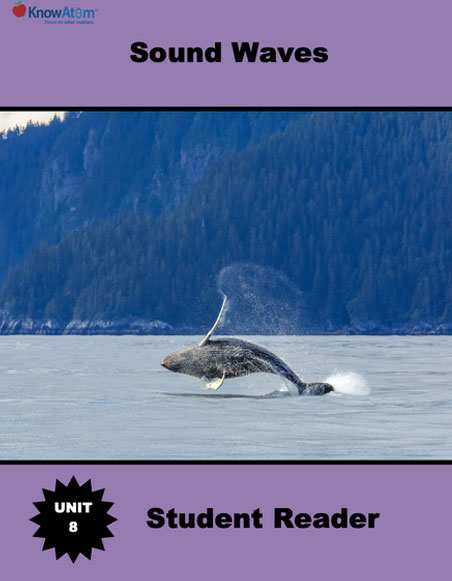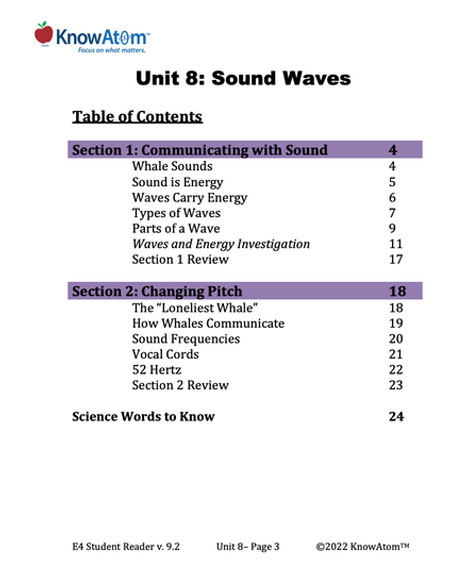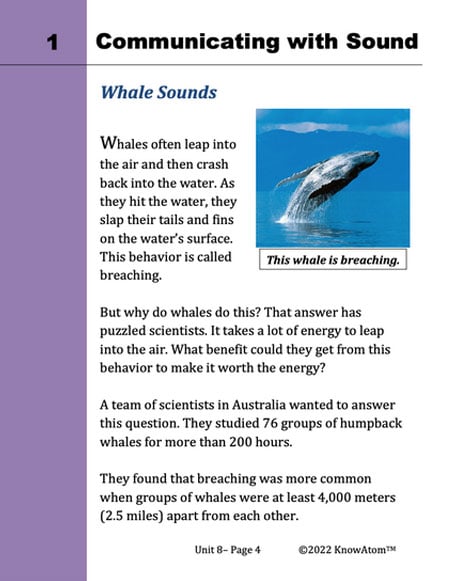Once students understand how waves transfer energy, they focus on a wave’s frequency and the factors that affect the pitch of sound produced by a stringed instrument.
In this lesson, students focus on figuring out the phenomena that is the pitch of a sound and the various factors that determine pitch. This page is a high-level extract of this lesson.
The science background section gives teachers more in-depth information about the phenomena students explore in this unit on sound waves. Here is an excerpt from the science background on pitch and volume.
In sound waves, the amplitude of a wave also determines the sound’s volume, which is how loud or soft a sound seems. For example, the scientists who studied the behaviors of humpback whales believe that whales breach to produce loud sounds that can travel long distances through the water by creating a large disturbance that carries more energy, similar to how a drum makes sounds that can be heard from far away.
Wavelength is the distance spanned by one cycle of the motion of the wave. In longitudinal waves, it is the distance from one compression to the next or from one rarefaction to the next. In transverse waves, it is the distance from crest to crest (the top of the wave) or from trough to trough (the bottom of the wave).
There is still much that scientists don’t know about how whales communicate. However, in recent years scientists have been able to better study whale sounds thanks to a series of hydrophones (underwater microphones) that were put in place during the Cold War to listen for Soviet submarine activity.
Those hydrophones are now being used to try to answer various scientific questions about how and why whales communicate with one another. As the largest animals on Earth, blue whales are particularly interesting because they can communicate over vast distances, at frequencies so low human ears cannot detect the sounds.
The frequency of a wave is the number of waves that pass a set point in a given amount of time. Frequency is closely related to pitch, which describes how high or low a sound seems. A wave with a higher frequency has a higher pitch than a wave with a lower frequency.
Humans can hear sounds at frequencies from about 20 hertz (Hz) to 20,000 Hz. Human speech is around 1,000 Hz to 5,000 Hz. The average human male speaking voice has a range between 85 and 155 Hz. The range for women is about 164 Hz to 255 Hz, and for a child about 250 Hz to 300 Hz. A standard piano keyboard covers a frequency range from 27.5 Hz to 4,186 Hz. In contrast, most blue whales vocalize in the range of 15 to 25 Hz.
In 1989, a group of scientists made an unusual discovery when listening to whale sounds in the North Pacific Ocean. They heard a signal coming from a whale that shared the same migratory patterns as other blue whales, but this whale was communicating at a frequency of 52 Hz, much higher than most other blue whales.
Every year for 12 years, the scientists recorded this whale, picking up its signals sometime in August or September and following it until it migrated out of range, sometime in January or early February.
The scientists published their findings in 2004, and were surprised when the story became covered by the mainstream news. The whale became known among non-scientists as “the loneliest whale in the world.” People worried that the whale couldn’t communicate with other whales.
Mary Ann Daher was a researcher in the lab that carried out the research, and she has received many emails from people worried about the whale, wanting to do something to help it.
As a scientist, Daher doesn’t like the label of “lonely” for a whale. “Obviously, he’s able to eat and live and cruise around,” Daher told the Washington Post in a 2012 interview, given that his sounds were still being recorded as of 2015. “Is he successful reproductively? I haven’t the vaguest idea. Nobody can answer those questions. Is he lonely? I hate to attach human emotions like that. Do whales get lonely? I don’t know.”
According to many scientists, other whales can still hear the whale when he communicates at 52 Hz (and they know he’s a male because males vocalize in this particular way during mating season). And the whale’s frequency is lower now, similar to how people’s voices deepen as they age and grow. The whale is now communicating at a frequency closer to 46 Hz.
Other scientists have concluded that whales have been changing their vocalizations as a way to compete with the increasingly noisy ocean, full of pollutants and noise caused by people.
Once students understand how waves transfer energy, they focus on a wave’s frequency and the factors that affect the pitch of sound produced by a stringed instrument.

Prepared hands-on materials, full year grade-specific curriculum, and personalized live professional development designed to support mastery of current state science standards.
Amplitude: a measure of the wave’s displacement from its resting position
Frequency: the number of waves that pass a set point in a given amount of time
Pitch: how high or low a sound seems
Vibrate: to move back and forth quickly
Wavelength: the distance spanned by one cycle of the motion of a wave

The “Loneliest Whale”
Mary Ann Daher has received many emails from people interested in one specific whale in the North Pacific Ocean.
This whale may be a blue whale. No one knows for sure. No one even knows if they’ve seen it. But many people have heard it. This whale has become known as the “loneliest whale in the world.”
Mary Ann doesn’t call the whale lonely. Other scientists don’t either. They don’t even know if whales get lonely. But non-scientists have called the whale lonely. A singer from Michigan wrote a children’s song about this whale. An artist in upstate New York made a sculpture of this whale.
How Whales Communicate
Why do so many people call this whale lonely? It has to do with how this whale communicates compared to other blue whales.
Blue whales are the largest animals on Earth. They are also the loudest animals on the planet. They communicate with other whales that are sometimes thousands of miles away. They make low grunts, moans, and clicks.
Sound is a useful way to communicate in the ocean. Sound travels about four times faster in the water than it does in the air. This is because the molecules in a liquid are closer together than in a gas. As a result, the molecules collide with one another more quickly in a liquid than in a gas because they don’t have to move as far to come into contact with one another.


Sound Frequencies
If you were to stick your head under water in the middle of the ocean, you likely wouldn’t be able to hear the sounds of blue whales. This is because these sounds are at much lower frequencies than people can hear.
Frequency is the number of waves that pass a set point in a given amount of time. It is measured in hertz (Hz). Frequency is closely related to pitch, which describes how high or low a sound seems. A wave with a higher frequency has a higher pitch than a wave with a lower frequency.
Most blue whales vocalize in the range of 15 to 25 Hz. These sounds are so low they are almost completely undetectable by human ears.
Vocal Cords
Humans can hear sounds at frequencies from about 20 Hz to 20,000 Hz. Human speech is around 1,000 Hz to 5,000 Hz. The average human male speaking voice has a range between 85 and 155 Hz. The range for women is about 164 Hz to 255 Hz. For a child, it is about 250 Hz to 400 Hz. Baby cries are about 500 Hz.
The structure of our vocal cords explains why men generally have lower-pitched voices than women. Vocal cords are folded membranes that vibrate, producing sound. Adult men have longer and thicker folds than adult women. Both of these factors produce lower-pitched sounds. Children have much shorter vocal cords than adults have.
In addition to length and width, tension also affects a sound’s pitch. Tension refers to how tightly something is stretched. An object with more tension produces a higher frequency sound than an object with less tension.
In this lesson, students carry out an experiment to figure out the factors that affect the phenomena of sound. Students create devices that produce sounds with string and then evaluate how a sound’s pitch is related to its frequency and can be changed by altering certain factors in their prototypes.
KnowAtom incorporates formative and summative assessments designed to make students thinking visible for deeper student-centered learning.

Standards citation: NGSS Lead States. 2013. Next Generation Science Standards: For States, By States. Washington, DC: The National Academies Press. Neither WestEd nor the lead states and partners that developed the Next Generation Science Standards were involved in the production of this product, and do not endorse it.
